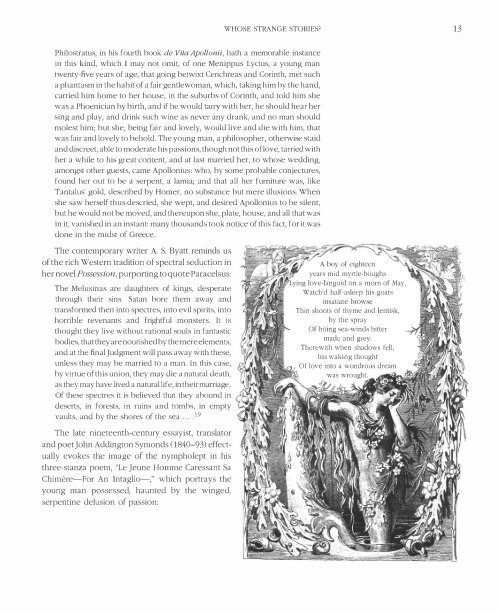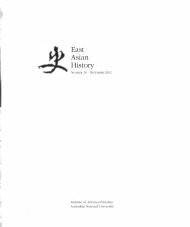Whose Strange Stories? P'u Sung-ling (1640 - East Asian History
Whose Strange Stories? P'u Sung-ling (1640 - East Asian History
Whose Strange Stories? P'u Sung-ling (1640 - East Asian History
Create successful ePaper yourself
Turn your PDF publications into a flip-book with our unique Google optimized e-Paper software.
WHOSE STRANGE STORIES?<br />
Philostratus, in his fourth book de Vita Apollonii, hath a memorable instance<br />
in this kind, which I may not omit, of one Menippus Lycius, a young man<br />
twenty-five years of age, that going betwixt Cenchreas and Corinth, met such<br />
a phantasm in the habit of a fair gentlewoman, which, taking him by the hand,<br />
carried him home to her house, in the suburbs of Corinth, and told him she<br />
was a Phoenician by birth, and if he would tany with her, he should hear her<br />
sing and play, and drink such wine as never any drank, and no man should<br />
molest him; but she, being fair and lovely, would live and die with him, that<br />
was fair and lovely to behold. The young man, a philosopher, otherwise staid<br />
and discreet, able to moderate his passions, though not this oflove, tarried with<br />
her a while to his great content, and at last married her, to whose wedding,<br />
amongst other guests, came Apollonius: who, by some probable conjectures,<br />
found her out to be a serpent, a lamia; and that all her furniture was, like<br />
Tantalus' gold, described by Homer, no substance but mere illusions. When<br />
she saw herself thus descried, she wept, and desired Apollonius to be silent,<br />
but he would not be moved, and thereupon she, plate, house, and all that was<br />
in it, vanished in an instant: many thousands took notice of this fact, for it was<br />
done in the midst of Greece.<br />
The contemporary writer A. S. Byatt reminds us<br />
of the rich Western tradition of spectral seduction in<br />
her novel Possession, purporting to quote Paracelsus:<br />
The Melusinas are daughters of kings, desperate<br />
through their sins. Satan bore them away and<br />
transformed then into spectres, into evil spirits, into<br />
horrible revenants and frightful monsters. It is<br />
thought they live without rational souls in fantastic<br />
bodies, that they are nourished by the mere elements,<br />
and at the final Judgment will pass away with these,<br />
unless they may be married to a man. In this case,<br />
by virtue of this union, they may die a natural death,<br />
as they may have lived a natural life, in their marriage.<br />
Of these spectres it is believed that they abound in<br />
deserts, in forests, in ruins and tombs, in empty<br />
vaults, and by the shores of the sea .. . . 19<br />
The late nineteenth-century essayist, translator<br />
and poet John Addington Symonds (1840-93) effectually<br />
evokes the image of the nympholept in his<br />
three-stanza poem, "Le Jeune Homme Caressant Sa<br />
Chimere-For An Intaglio-," which portrays the<br />
young man possessed, haunted by the winged,<br />
serpentine delusion of passion:<br />
years mid myrtle-boughs<br />
love-languid on a morn of May,<br />
Watch'd half-asleep his goats<br />
insatiate browse<br />
Thin shoots of thyme and lentisk,<br />
by the spray<br />
Of biting sea-winds bitter<br />
made and grey:<br />
Therewith when shadows fell,<br />
his waking thought<br />
Of love into a wondrous dream<br />
was wrought.<br />
13

















